
Ancient art refers to the many types of art produced by the advanced cultures of ancient societies with different forms of writing, such as those of ancient China, India, Mesopotamia, Persia, Palestine, Egypt, Greece, and Rome. The art of pre-literate societies is normally referred to as prehistoric art and is not covered here. Although some pre-Columbian cultures developed writing during the centuries before the arrival of Europeans, on grounds of dating these are covered at pre-Columbian art and articles such as Maya art, Aztec art, and Olmec art.

The Thinker, by Auguste Rodin, is a bronze sculpture situated atop a stone pedestal depicting a nude male figure of heroic size sitting on a rock. He is seen leaning over, his right elbow placed on his left thigh, holding the weight of his chin on the back of his right hand. The pose is one of deep thought and contemplation, and the statue is often used as an image to represent philosophy.

Most African sculpture was historically in wood and other organic materials that have not survived from earlier than at most a few centuries ago; older pottery figures are found from a number of areas. Masks are important elements in the art of many peoples, along with human figures, often highly stylized. There is a vast variety of styles, often varying within the same context of origin depending on the use of the object, but wide regional trends are apparent; sculpture is most common among "groups of settled cultivators in the areas drained by the Niger and Congo rivers" in West Africa. Direct images of African deities are relatively infrequent, but masks in particular are or were often made for traditional African religious ceremonies; today many are made for tourists as "airport art". African masks were an influence on European Modernist art, which was inspired by their lack of concern for naturalistic depiction.

The Sutphin Fountain is a fountain located at the Newfields campus, directly adjacent to the Indianapolis Museum of Art (IMA), which is near downtown Indianapolis, Indiana. The granite and concrete fountain was designed by Stuart O. Dawson of Sasaki, Dawson, DeMay Associates, Inc. in 1972.

Numbers 1-0 is a public artwork by the American artist Robert Indiana, located at the Indianapolis Museum of Art (IMA), which is near downtown Indianapolis, Indiana. This series of sculptures is composed of 10 brightly painted numerical digits, each made of aluminum and set on its own base. Their construction took place at the former Lippincott Foundry in North Haven, Connecticut from 1980 to 1983.

Snowplow is an abstract outdoor sculpture by American artist Mark di Suvero located on the grounds of the Indianapolis Museum of Art. The sculpture was purchased in 1975 by the Indianapolis Sesquicentennial Commission and first installed in Indianapolis, Indiana in 1977.
Portrait of History, a public sculpture by Chinese American artists Zhou Brothers, is located on the Indiana University-Purdue University Indianapolis campus, which is near downtown Indianapolis, Indiana. The sculpture is located at the Blackford Street entrance to the Herron School of Art and Design. This piece is one of four public artworks on loan from the Indianapolis Museum of Art to IUPUI. The artworks were moved to the campus on March 22, 2009. Portrait of History is a bronze sculpture measuring 100 x 24 x 30 in and is mounted on an oval cement base.
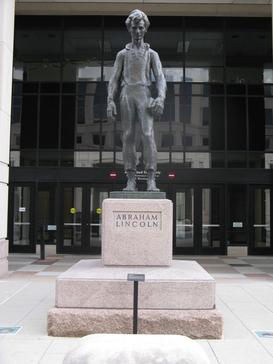
Young Abe Lincoln, is a 1962 public artwork by American artist David K. Rubins, located outside of the government center near the Indiana State House, in Indianapolis, Indiana, US. This bronze sculpture is a depiction of a young Abraham Lincoln, an Abraham Lincoln that spent the majority of his formative years in Indiana.

Stumbling Man is an outdoor sculpture by American artist David K. Rubins (1902–1985) located on the grounds of the Indianapolis Museum of Art (IMA), which is near downtown Indianapolis, Indiana. The sculpture is cast bronze and is in the shape of a man crouched upon the ground.

Nymph and Fawn is a public artwork by American artist Isidore Konti and located within the Oldfields–Lilly House & Gardens estate on the grounds of the Indianapolis Museum of Art (IMA), near Indianapolis, Indiana. Created in 1917, the bronze sculpture is also a working fountain. It portrays a female nude pouring water from an urn while standing beside a small fawn.
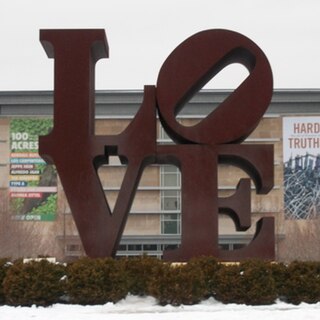
LOVE is an artwork by American pop artist Robert Indiana (1928–2018), located at the Indianapolis Museum of Art at Newfields in Indianapolis, Indiana, United States. It was created in 1970 as the first sculptural form of the artist's 1965 LOVE painting and has been on continuous exhibition at the Indianapolis Museum of Art since it was acquired in 1975.
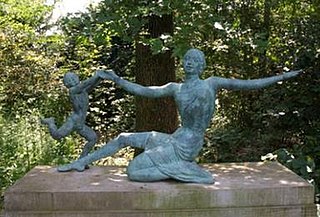
Mother and Child is a public artwork by the Estonian-British artist Dora Gordine, located at the Indianapolis Museum of Art (IMA), which is near downtown Indianapolis, Indiana. The cast bronze artwork was created in 1964 and portrays a woman kneeling beside a small child, both figures displaying joyful poses and expressions.
La Hermana del Hombre Bóveda is a public artwork by Spanish artist Pablo Serrano, located at Newfields, the museum campus that houses the Indianapolis Museum of Art near downtown Indianapolis, Indiana. The artwork is an abstract bronze piece which tops a granite fountain.

The Three Graces is a nearly life-size, figurative Carrara marble outdoor sculpture group located on the historic Oldfields estate on the campus of the Indianapolis Museum of Art (IMA), in Indianapolis, Indiana. The neoclassical marble sculpture depicts the Three Graces, minor goddesses of the Greco-Roman pantheon. The group consists of three women frontally oriented, standing in a row upon a base. The sculpture is modeled after a c. 1797 sculpture by Antonio Canova.

Female Herm and Male Herm are a set of two neoclassical marble herms in the outdoor sculpture collection of the historic Oldfields estate, located on the campus of the Indianapolis Museum of Art (IMA), in Indianapolis, Indiana. Together the herms depict either Dionysus and a Maenad or a dryad and a satyr.

Free Basket is a public artwork by the Cuban artist group Los Carpinteros, located in the 100 Acres: The Virginia B. Fairbanks Art and Nature Park, in Indianapolis, Indiana, United States. The artwork is in the form of an international basketball court with twenty-four red or blue steel arches that travel throughout the court, mimicking the trajectory of two bouncing basketballs. Two of the arches terminate with their own regulation size basketball hoop, netting, and backboard.
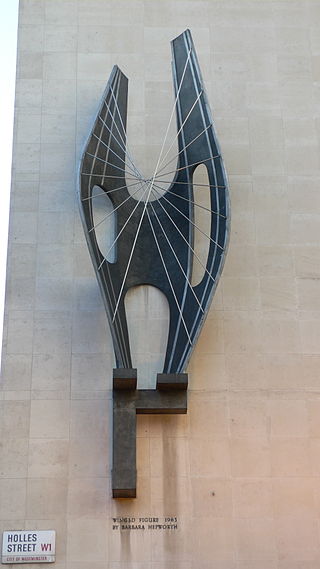
Winged Figure is a 1963 sculpture by British artist Barbara Hepworth. One of Hepworth's best known works, it has been displayed in London since April 1963, on Holles Street near the junction with Oxford Street, mounted on the south-east side of the John Lewis department store. It is estimated that the sculpture is seen by approximately 200 million people each year.
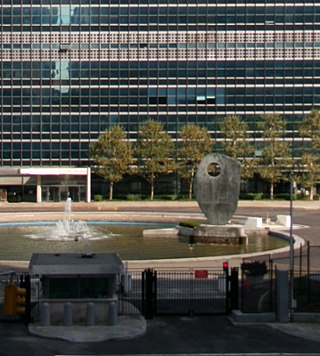
Single Form is a monumental bronze sculpture by the British artist Barbara Hepworth. It is her largest work, and one of her most prominent public commissions, displayed since 1964 in a circular water feature that forms a traffic island at the Headquarters of the United Nations in New York City, outside the United Nations Secretariat Building and the Dag Hammarskjöld Library. It is also the largest artwork cast by the Morris Singer foundry.

Four-Square is a 4.3 metres (14 ft) high bronze sculpture by British artist Barbara Hepworth. It was cast in 1966 in an edition of 3+1. The four casts are displayed at the Barbara Hepworth Museum, the Norton Simon Museum, Churchill College, Cambridge, and the Mayo Clinic.

















